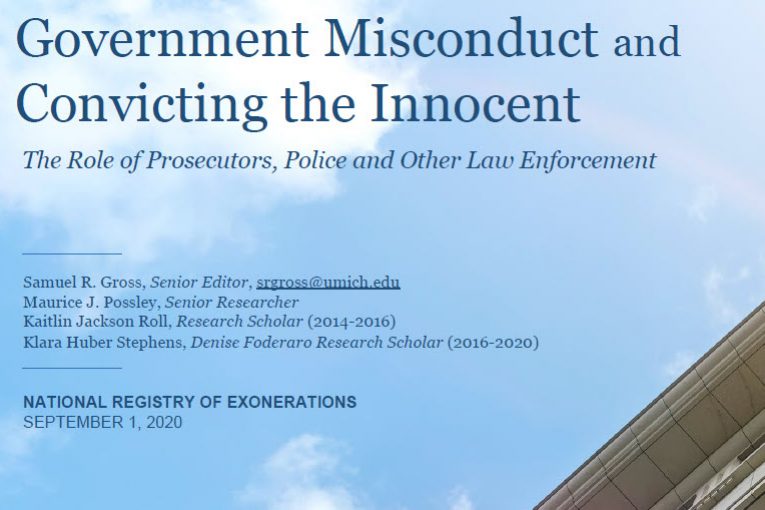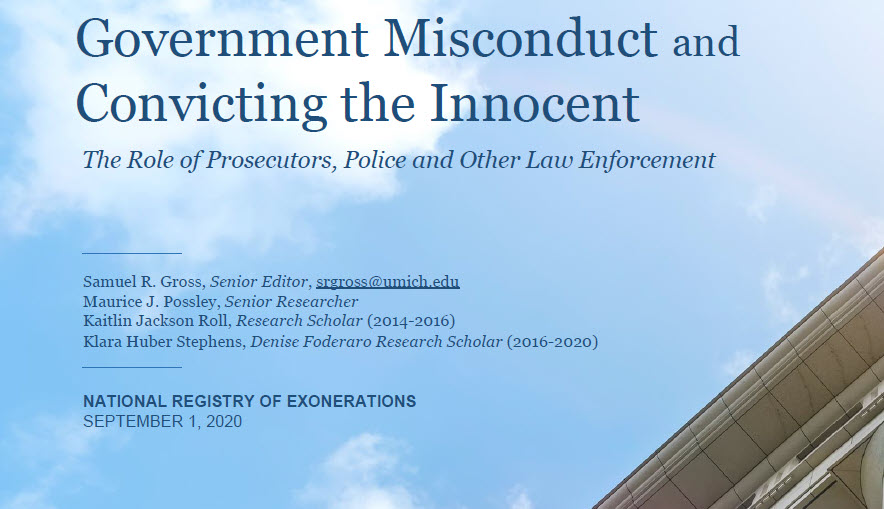

(This is the third in an 11-part series by The Vanguard reporting on a study of exonerations produced by Samuel R. Gross, Maurice J. Possley, Kaitlyn J. Roll, and Klara H. Stephens)
By Layla Mustafa
Across the varying types of misconduct researched in a study by Samuel R. Gross, Maurice J. Possley, Kaitlyn J. Roll, and Klara H. Stephens, “Witness Tampering” played an official role in the convictions of 17 percent of the exonerations studied.
In the practice of shaping and altering witness testimony, there is shifting leniency as to what is permissible by officials, said researchers, noting that prosecutors and law enforcement are allowed to aid in a witnesses’ recollection of past events or in their trial preparation, and in doing so they sometimes distort witness testimony.
This distortion may be procured as a result of practices such as a “suggestive” lineup for identification. While this can lead to dangerous outcomes for the fate of the accused, this incompetence is classified as “suggestiveness” and not actual misconduct.
Witness Tampering is the deliberate and successful attempt by law enforcement officials to encourage witnesses to give false evidence or withhold true evidence. Official encouragement of witnesses is commonly committed through threats and/or manipulation.
Exonerations which include witness tampering exercised through threats total for five percent of the cases, and witness tampering exercised through manipulation totals for 13 percent of cases, according to Samuel R. Gross, Maurice J. Possley, Kaitlyn J. Roll, and Klara H. Stephens, adding it is not a requirement of the officer to be actively aware the witness is testifying falsely – it is simply misconduct to trick or persuade the witness to testify something they may have seen…whether they actually saw it or not.
Witness tampering is unevenly distributed across crimes and tends to be much higher for murders and sexual abuse cases. In fact, the study found that nearly 80 percent of the witness tampering exonerations include murder, child abuse, and sexual abuse. These percentages rise when research specifically considers witness tampering that involves the use of threats.
The study shows witness tampering is primarily found among law enforcement officials as opposed to prosecutors. It is more common for the police to engage in witness tampering because they tend to be the main investigators to find, interview and take statements from witnesses. Through use of threats and/or manipulation, officials are able to obtain one of the three most common types of witness tampering: procuring false testimony, tainted identification, and improper questioning of a child victim.
These three types of witness tampering are unevenly distributed across crime types. Procuring false testimony was most common in murder exonerations, tainted identifications were most common in sexual assault exonerations, and improper questioning of a child occurred exclusively in child sexual abuse exonerations.
In the case of false testimony, both police and prosecutors attained false testimony in equal numbers, said Samuel R. Gross, Maurice J. Possley, Kaitlyn J. Roll, and Klara H. Stephens. Procuring false testimony is the practice of inducing a civil witness to testify facts that the official is aware the witness did not actually perceive.
False testimony is an extreme form of misconduct, and only occurs in about six percent of exonerations studied. Two-thirds of witness tampering resulting in fake testimonies were for murder cases. Due to the common lack of eyewitnesses to murders, officials tend to search for credible eyewitness testimony in order to solidify a case.
Securing false testimony can range from threatening or manipulating a witness to something as simple as notifying a witness prior to trial where the accused will be sitting in court for identification.
In the case of tainted identifications, all misconduct but two were committed by law enforcement officers, the study found.
Tainted identifications occur when police deliberately induce a witness to identify a suspect during a lineup or other identification procedure, whether or not the witness recognizes the suspect. A disclaimer made by the researchers noted that while many identifications are poorly designed, and may lead to terrible mistakes, that doesn’t necessarily qualify it as a “tainted” identification.
For example, in a 1985 rape investigation, the police showed the victim six color photographs which were all standard police profile mugshots. There had been no profile mugshot available for the accused, so law enforcement presented a polaroid of the accused facing the camera. While this case was poorly designed and indicated the accused, it was not qualified as a “tainted identification,” but instead “suggestive” and bad policing.
Tainted identifications are only qualified as misconduct when officials intentionally structure the identification process to encourage the witness to identify the accused, said the researchers, adding one example occurred in Pittsburgh, when a rape victim was able to identify the accused man’s photo in a lineup – his photo was the only one marked with an “R” for rapist. This man was later exonerated through the use of DNA testing.
About 75 percent of known tainted identifications occurred in murder and sexual assault cases. In murder cases, nearly 80 percent of the witnesses deliberately misidentified exonerees. In 35 percent of these cases, police officers were able to get witnesses to misidentify exonerees through the use of threats.
In sexual assault exonerations, the victims always survive, and thus, serve as the critical eyewitness. For this reason, none of the tainted identification in sexual assault exonerations included threats by the police; and all but one produced mistaken witness identification. This information only aids in helping us understand the motive for police to threaten witnesses in murder cases. Without the substantial evidence presented by the primary eyewitness, it is much more difficult to build a case against the accused.
The final category of witness tampering includes the improper questioning of a child victim. This is the repeated and suggestive questioning of a child by a government official who will not allow the child to deny sexual abuse. Unlike adult sexual assault cases, victims are consistently threatened to identify the accused.
Nearly 80 percent of the exoneration studies with improper questioning of a child victim were a result of an epidemic of child abuse hysteria from the early 1980s to the late 1990s, the study found.
The influence of this epidemic led the researchers to believe that it is likely that both the officers and social workers conducting the investigations did genuinely believe that sexual assaults were occurring. Because of this stringent belief, many overeager police officers and child welfare workers would not accept “no” as an answer from the children.
Once the epidemic passed, many children who testified came forward to state that they had been misled or manipulated in their interrogation to falsely accuse the exoneree. A police officer cited in the study pointed to the fact that interviews were “much less sophisticated in 1984.” Once the epidemic passed however, no more recent convictions of that sort were found.
The Samuel R. Gross, Maurice J. Possley, Kaitlyn J. Roll, and Klara H. Stephens study found witness tampering is most common among the worst violent crimes that appear in exonerations. And it tends to be less common across non-violent crimes. All three types of witness tampering: procuring false testimony, tainted identification, and improper questioning of a child victim, are carried out through the use of threats and/or manipulation.
To sign up for our new newsletter – Everyday Injustice – https://tinyurl.com/yyultcf9
Support our work – to become a sustaining at $5 – $10- $25 per month hit the link:





